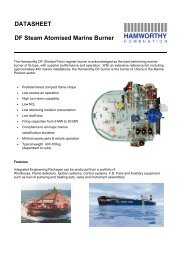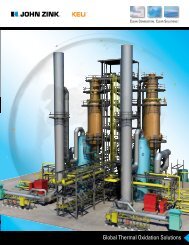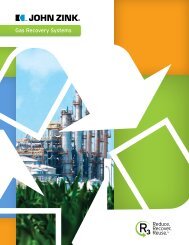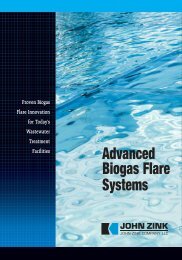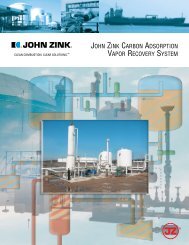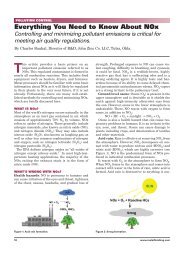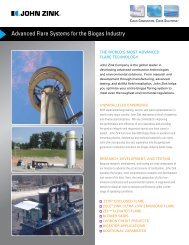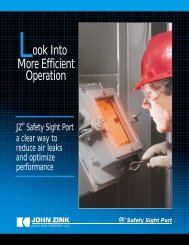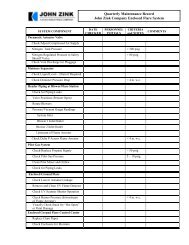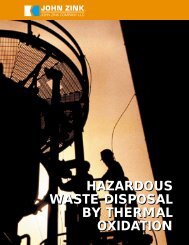Control refinery NOx emissions cost-effectively - John Zink Company
Control refinery NOx emissions cost-effectively - John Zink Company
Control refinery NOx emissions cost-effectively - John Zink Company
Create successful ePaper yourself
Turn your PDF publications into a flip-book with our unique Google optimized e-Paper software.
Fig. 7. NO x results at various steam additions—25 lb and 46 lb.<br />
gas without modifying, replacing or adding fans. Previous successful<br />
conversions and comparison results of fuel dilution vs.<br />
FGR, concluded that developing a new low-NO x burner using<br />
fuel-dilution technology was the best strategy to meet the<br />
latest California regulations.<br />
Burner development. Because the <strong>refinery</strong>’s co-generation<br />
plant and other steam producers yield excess steam, the No. 5<br />
Riley boiler was available and provided an ideal situation for<br />
prototype testing. The engineering consultant designed, fabricated<br />
and installed five prototype fuel-dilution burners that<br />
used multiple gas nozzles and available fuel pressure to induce<br />
flue gases from an integral flue gas plenum.<br />
The system design included fuel-dilution burners, ducting<br />
to transport the flue gases from the stack to the prototype<br />
burners, a small amount of induced FGR supplied to the<br />
existing fan, and a steam-injection sparger in the fuel-dilution<br />
line. To provide optimum safety and reliability, a new<br />
burner management system was also installed. The only<br />
design restriction involved the original burner openings in<br />
the windbox and boiler front wall, which needed to remain<br />
unaltered so that the original burners could be reinstalled<br />
should the experiments fail. After installing and optimizing<br />
the system, the prototype burners and steam-sparging system<br />
consistently produced NO x levels of 15 ppm to 20 ppm,<br />
corrected to 3% O 2.<br />
Production burner supply. The results of the prototype testing<br />
on boiler No. 5 clearly indicated that fuel-dilution technology<br />
was a viable solution. A burner company with fueldilution<br />
experience was commissioned to retrofit the<br />
remaining boilers.<br />
Based on the initial prototypes, the burner engineers worked<br />
closely with the <strong>refinery</strong> team and engineering consultant to<br />
finalize the new, low-NO x design, supply production burners<br />
to retrofit the four remaining boilers, and to replace the prototypes<br />
on boiler No. 5. The burner engineers also performed<br />
an air-distribution study of the windboxes and combustion air<br />
systems using in-house physical modeling technology to<br />
ensure balanced airflow and optimum burner performance of<br />
each unit. Based on the modeling results, baffles were added<br />
to the windboxes to balance airflow for stable flame formation<br />
without combustion-induced boiler vibration and to minimize<br />
excess air levels and boiler <strong>emissions</strong>.<br />
Realizing that any recycling of flue gases would increase<br />
mass flow through the boiler, thus increasing convective section<br />
velocities and superheat temperatures, the lengths of<br />
convection section baffles above and below the superheat<br />
tubes were modified in all boilers except No. 7. This unit historically<br />
had lower steam superheat temperatures than the<br />
HYDROCARBON PROCESSING / NOVEMBER 2001<br />
maximum design superheater outlet temperature, resulting<br />
in the superheat temperature staying within the operating<br />
limits of the boiler.<br />
Power-boiler retrofit results. Low-NO x burner installation on<br />
the four remaining boilers began in February 2000 and was completed<br />
by mid-July 2000 (Fig. 5). The prototype burners on boiler<br />
No. 5 were also replaced with low-NO x burners in May 2001.<br />
All the retrofitted boilers operate on a 24/7 basis and consistently<br />
maintain NO x <strong>emissions</strong> at or below 25 ppm, corrected<br />
to 3% O 2 (Fig. 6.)<br />
The boilers can achieve single digit NO x ratings with additional<br />
sparging of low-pressure steam, if available, with almost<br />
no additional operating expense (Fig. 7). Since this plant has<br />
to let down 850-psig steam for sparging, which can result in<br />
a considerable ongoing operating expense, the <strong>refinery</strong> wanted<br />
to control the steam-injection rate to the amount required for<br />
the boilers to stay below their permitted NO x levels. Therefore,<br />
James G. Seebold has more than 35 years experience<br />
consulting with Chevron’s operating centers and affiliated<br />
companies worldwide on all aspects of the design,<br />
operation and maintenance of burners, fired-heaters, furnaces,<br />
incinerators, boilers and flares. His area of expertise<br />
also includes: low-NO x burners, selective catalytic<br />
and noncatalytic NO x reduction systems, hazardous air<br />
pollutant <strong>emissions</strong>, onshore plant, offshore platform<br />
and shipboard noise control engineering. He currently<br />
serves as his company’s main contact person for the<br />
International Flame Research Foundation and as director of the Noise <strong>Control</strong><br />
Foundation. Past positions include technical advisor for the DOE Study of Oxygen<br />
Enriched Combustion, technical advisor for the EPA Study of Industrial Flares<br />
and president for the Institute of Noise <strong>Control</strong> Engineering. Dr. Seebold conceived<br />
and led the American Petroleum Institute’s Detonation Arrester Testing<br />
Program for applications in fired marine-vapor disposal systems. He conceived<br />
and led a 4-year, $7-million, 20-participant industry-government-university<br />
collaboration on trace combustion byproducts that led to successful public<br />
policy intervention on Combustion MACT. Dr. Seebold holds a doctorate degree<br />
in mechanical engineering from Stanford University.<br />
Richard T. Waibel is director of engineering and<br />
design for the combustion technology team in the <strong>John</strong><br />
<strong>Zink</strong> Co., burner group. Dr. Waibel has been with the<br />
<strong>John</strong> <strong>Zink</strong> Co. since 1983. He is a graduate of Pennsylvania<br />
State University, with a BS and Ph.D. degrees<br />
in fuel science. He and his team are responsible for providing<br />
customers with innovative burner designs and<br />
combustion solutions. Prior to joining <strong>John</strong> <strong>Zink</strong>, Dr.<br />
Waibel was assistant director of Industrial Energy Utilization<br />
at the Institute of Gas Technology in Chicago.<br />
He is a member of The Combustion Institute and has been a member of the American<br />
Flame Research Committee and the International Flame Research Foundation.<br />
He has been chairman of the American Flame Research Committee since<br />
1995. Dr. Waibel has authored numerous industry papers—many of which can<br />
be accessed at www.johnzink.com. He is also a contributing author of The<br />
<strong>John</strong> <strong>Zink</strong> Combustion Handbook.<br />
Timothy L. Webster is the director of marketing for the<br />
TODD Combustion Group of <strong>John</strong> <strong>Zink</strong> Co., LLC. He joined<br />
<strong>John</strong> <strong>Zink</strong> in August of 1999 as the product line manager<br />
for the TODD Rapid Mix Burner (RMB). Mr. Webster quickly<br />
expanded his role to act as manager for new technologies.<br />
In 2001, Mr. Webster moved into his current role heading<br />
up TODD’s marketing efforts and focusing on new opportunities<br />
for business and product development. He has<br />
authored papers on several combustion topics, including<br />
biomass combustion, ultra-low emission burners, gas-fuel<br />
conditioning, combustion modeling and other NO x reduction techniques for boilers,<br />
many of which can be accessed at www.<strong>John</strong><strong>Zink</strong>.com. He was also one of<br />
the contributing authors of The <strong>John</strong> <strong>Zink</strong> Combustion Handbook. Mr. Webster<br />
received a BS degree in mechanical engineering from San Jose State University<br />
and an MS degree from the University of Wisconsin. He is also a licensed professional<br />
mechanical engineer.



